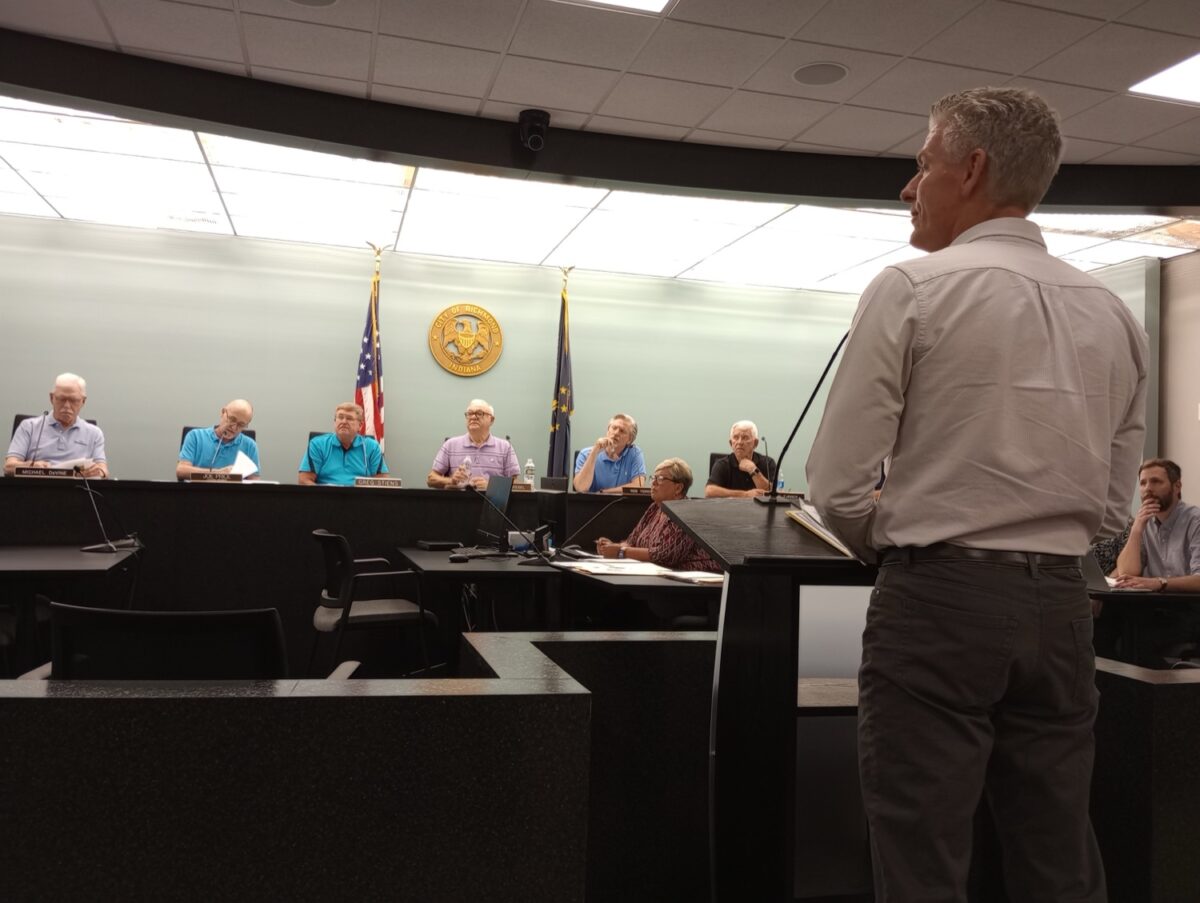Alterations to the Smith Hill development plan didn’t assuage neighbors’ opposition.
About 50 people attended the July 24 Richmond Advisory Plan Commission when it considered the second zoning request for the planned unit development. The original request by 11th Street Development was rejected by Richmond Common Council in April, although the plan commission had recommended approval.
Developer Bryan Stumpf reworked the proposed development south of Backmeyer Road between South 37th Street and Garwood Road. He replaced 220 apartments with 110 townhomes in the northwest portion of the 80-acre development, and he removed consideration for an on-site day care facility.
Neighbors, however, returned with their same concerns, including the density of the development, which still includes 178 single-family homes in four styles.
“The changes seem to be minimal, not really addressing water, drainage, sewer, traffic,” Dawn Otto said. “There’s a lot of things that haven’t really been addressed.”
Otto was one of eight people speaking against the zoning changes necessary to offer the mixture of housing options proposed. Ten people spoke in favor of the development, citing the importance of additional housing and housing variety in the city’s and county’s futures. In addition, 100 people responded to letters announcing the public hearing. Two were in favor and 98 opposed, including 40 who had comments read into the plan commission meeting’s record.
With seven members present, the plan commission voted 6-1 to recommend council approve the requested zoning changes. Council, which next meets Aug. 5, will make the final determination whether the new zoning request is approved or denied.
Zoning is the first phase of a three-phase process, a concept stressed several times during the meeting. Plan commission — then council — only at this time considers the use of the land, which is owned by a Reid Health-formed limited liability company. The developer would next need to submit detailed plans, including for the issues Otto mentioned, and those plans would require city approval.
“I’m anxious to see this go forward, because in our next phase, we’ll finally be able to address the issues you’ve brought to our attention,” said Gary Turner, a plan commission member who’s also the council president. “That’s very important to me. I can assure you that I’m not going to vote favorably on a plan that doesn’t address all the issues you’ve brought up.”
Neighbors revisited concerns about their battles with existing infrastructure, the safety of proposed retention ponds and the addition of 388 living units. They said traffic would increase beyond the capabilities of Backmeyer and Garwood roads, especially with another 232-unit senior housing development already approved farther south on Garwood.
Opponents also question the ability of Richmond residents to afford the homes, which start at more than $250,000, and the feasibility of enticing out-of-county people to buy in the development.
“They choose to live outside of our community because, not housing, but the blight in our city, the stuff that needs to be repaired or torn down,” Shelly Culbertson said. “They choose to not come here because the rating of our schools.”
Concerns were expressed that development would expand the east side.
“Building this many homes in the busiest square mile of Richmond suggests that the east side of town is becoming the center of town instead of where the city building and courthouse are located,” Otto said. “There has to be a better use of resources to enhance, expand and revive other parts of Richmond and better serve the city and its residents.”
Multiple opponents said they opposed the use of tax money for the development. Stumpf said he has applied to the East Central Indiana Regional Partnership for Regional Economic Acceleration and Development Initiative money to help fund the development’s infrastructure. Every READI 2.0 dollar awarded would require a $3 private match and a $1 public match.
Wayne County is one of eight counties in ECIRP that received a $35 million READI 2.0 award. Housing growth has been identified as a regional priority, with ECIRP hoping to help build 3,000 additional housing units with its READI allotment.
Misti Foust-Cofield, a Reid Health vice president, said there are 12,000 commuters to Wayne County each day. At Reid, 1,400 of 3,200 employees commute from outside Wayne County.
“If just a portion of these individuals move to Wayne County, we would see a much stronger tax base, increased retail, higher local school enrollments, improved population health, increased participation for our nonprofits and overall growth in our region that promotes future investment in our county,” she said. “This is why the READI 2.0 process identified housing as the region’s top barrier, our top barrier in the entire region.”
Other supporters also expressed the need for additional housing and for diverse housing options. Inadequate housing not only restricts county growth, but hampers companies searching for workers.
“If we want to continue to attract talent and people to work at the businesses that we’re working so hard to recruit and grow, we have to have housing options for them,” said Valerie Shaffer, president of the Economic Development Corporation of Wayne County.
Wayne County Commissioner Brad Dwenger, a real estate appraiser, said the county has 1.36 months of housing supply currently available. There are 97 homes on the market with an average asking price of $266,604. Since the beginning of 2023, homes have averaged 63 days on the market before sales.
Smith Hill’s variety of home options fits families in various stages of life. Some might need first homes, some might need larger homes and some might be downsizing. That turnover helps replenish the market supply.
“In order to keep having that cycle of people moving up, moving down, you’ve got to have the homes available, and currently, we do not have those properties available,” Dwenger said.
A version of this article appeared in the July 31 2024 print edition of the Western Wayne News.

